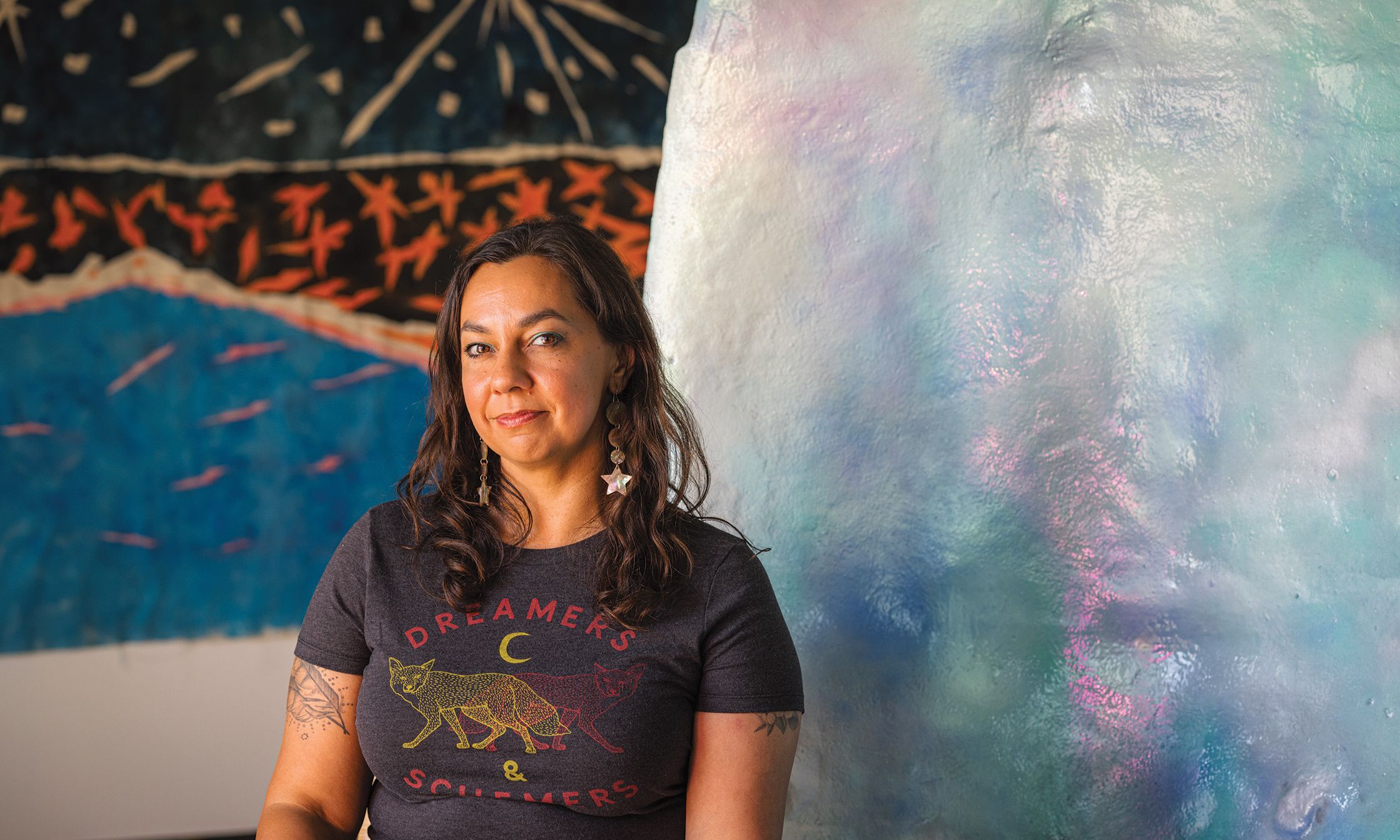Mercedes Dorame has been exhibited internationally, but remains rooted in the Los Angeles area, the home of her ancestral people © 2023 J. Paul Getty Trust
Mercedes Dorame, a Los Angeles-based artist of Gabrielino-Tongva heritage, engages with her ancestry to explore themes around cultural construction. Her installation Woshaa’axre Yaang’aro (Looking Back) (2022)—the inaugural project of the Getty Museum’s Rotunda Commission series at the Getty Center—comprises a series of luminescent suspended sculptures that evoke abalone shells and elements of the Los Angeles coastline. The work honours the Tongva, one of the tribes that originally inhabited the Los Angeles Basin and the Southern Channel Islands. Dorame’s work was featured in the Hammer Museum’s 2018 Made in L.A. biennial and has been exhibited internationally. She received her MFA from the San Francisco Art Institute and undergraduate degree from UCLA, which has included her in the centennial initiative UCLA: Our Stories, Our Impact. Her solo exhibition, Where Sky Touches Water, is at Oxy Arts in Los Angeles (until 20 April).
The Art Newspaper: Over the past two decades, you have served as a cultural resources consultant on Tongva sites in the Los Angeles Basin, working on the repatriation of ancestral Tongva human remains and objects. How has that experience informed your artistic practice?
Mercedes Dorame: It’s made me connect with the land and understand how much history exists in Los Angeles. The process of watching the explanation of culture has made me consider the cultural context of objects, how we interact with them and the meaning imbued in them over time. It’s also a job where you are giving recommendations; there’s no power in it, yet there’s great responsibility. It’s about grappling with how to deal with the weight of responsibility in a way that honours our people and how to find an empowered way to move through our experiences, which has been integral to my work.
Dorame’s installation Woshaa’axre Yaang’aro (Looking Back) at the Getty Center Photo: Rebecca Vera-Martinez
The abalone in Woshaa’axre Yaang’aro (Looking Back) are a recurring motif in your work. What does it symbolise?
The abalone is incredibly important to the Tongva and most Native people, historically. It had a functional purpose; they were used to make fishhooks, for example, or as a food source. There’s both sustenance and ceremonial elements to it. My interest in the abalone started when I was part of the 2021-22 cohort for the Unseen California initiative at UCLA, when I was researching the Channel Islands and saw living abalone for the first time. In Los Angeles, the abalone were desecrated and the population completely destroyed. People just collected them all. For me, the living abalone became this symbol of possibility and the multiplicity of existence.
The abalone also became a metaphor for the Tongva’s ancestral land. It made me reflect on something one of our tribal elders said when we talked about Land Back and how borders were once more fluid. He said, “Where does someone’s territory end and ours begin? Look at an abalone shell and tell me where the pink ends and where the green begins.” People want a line on the map, he said, but borders shift and change with perspective. I also always try to fight against the impulse to categorise or have these solid-minded, rigid edges to my approach.
The installation went on view in June last year. What conversations has it sparked since then?
There’s been a gamut. I love walking in there and seeing children just stop in their tracks and see how they interact with the works. I know that not everyone is comfortable in those spaces, so engaging with children is an important aspect of the project. I met a team of abalone scientists who are working in San Pedro to repopulate the coast and understand the abalone better. When I saw the abalone in the Channel Islands, they were vibrant and abundant but [they] were actually part of a research station. We’re both approaching the abalone from a research perspective, so engaging with scientists has led to some generative conversations. It’s also been interesting to see the response from the audience [to the installation] as the sun shifts and moves. When we first installed it, you couldn’t see the reflection until late in the afternoon. Because of the angle of the sun now, since we’ve moved over the winter solstice, all of the colour is reflected and falls onto the floor of the museum. People seem to look up and try to reorient themselves.
A detail showing an abalone shell, important practically and culturally to the local Tongva people Photo: Rebecca Vera-Martinez
What is significant about showing this installation in a museum in Los Angeles, where so many tribes are still seeking federal recognition, and as concerns around repatriation are coming to the fore?
When I think about working with institutions, it’s important to know that there’s an intention to engage in a meaningful way. I’ve seen these types of engagements go really well and sometimes very poorly—the heart of the difference is intention. I’ve thought about what it means to exist in a museum and own your cultural territory.
I grew up in Los Angeles going to the Getty. I remember when that place was built. But there’s people who live in Los Angeles who didn’t know about the Tongva until this exhibition. I don’t want my daughter to have to have that conversation. For me, it’s been important to get the message out about who we are and that we’ve always been the original caretakers of this place. That’s the end goal.
• Mercedes Dorame: Woshaa’axre Yaang’aro (Looking Back), Getty Center, Los Angeles, until 11 August

